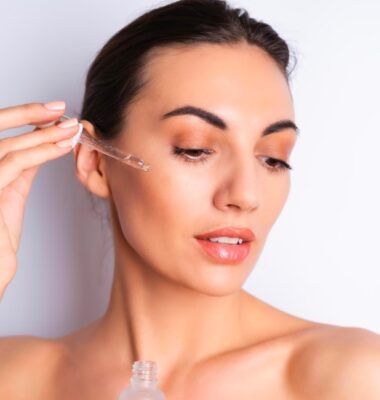6 Common Sunscreen Myths – Let’s Separate Fact from Fiction
By Daniela Moreno, Certified Health Coach
Last Updated on November 23rd, 2023 / Published on June 2, 2023

Confused about sunscreens? You are not alone. Understanding and practicing proper sun protection, particularly by using SPF (Sun Protection Factor) correctly, is crucial for maintaining the long-term health of your skin.
The skincare industry has experienced substantial growth over the past two decades and is currently valued at billions of dollars worldwide. As a result of this growth, there have been instances of misinformation and false advertising, which unfortunately have been misleading consumers over the years.
In this blog, we will separate fact from fiction and debunk the most common skincare myths to help you achieve healthy, glowing skin with summer around the corner and all year round. We will also explore the several reasons why myths and misconceptions surrounding sunscreens persist and distinguish the main differences between mineral and chemical sunscreens.
Remember that understanding product ingredients, reading labels, and relying on credible sources of information are crucial aspects to make well-informed decisions not only for your skin but also for your overall health and well-being.
Myth 1: Higher SPF provides significantly better protection
The higher SPFs tend to give people a false sense of security against the sun, leading to skin damage. The truth is, no sunscreen can offer 100% protection. Let’s delve into what the number on your sunscreen bottle means. SPF indicates how well a sunscreen protects against ultraviolet (UV) B rays, which are primarily responsible for sunburn. However, SPF does not directly correlate with the level of protection. For instance, SPF 30 blocks about 97% of UVB rays, SPF 100 blocks 99% of UVB rays 1 and SPF 50 blocks around 98%; henceforth, the marginal difference in sun protection is minimal.
Myth 2: I don’t need sunscreen during winter or cloudy days
Sunscreen should be worn every day, regardless of the weather or season. Sunscreen is essential whether you are exposed to the sun, staying home, going about your daily routine, playing sports, or enjoying a day at the beach. Harmful UV rays can penetrate through clouds and windows, even if it is cloudy, possibly leading to skin damage. So, it is important to wear sunscreen daily irrespective of the weather forecast.
Myth 3: Applying sunscreen once or two times a day is enough
Sunscreen should be reapplied every two to three hours. Moreover, if you are swimming or sweating, you should reapply it frequently. Even waterproof or water-resistant sunscreens can wear off over time, so it is important to reapply regularly.
Myth 4: Sunscreen prevents the body from producing vitamin D
Vitamin D is an essential vitamin made when the protein in our skin reacts to UVB rays from the sun. However, there is a common concern that using sunscreen may limit vitamin D production. Although sunscreen can reduce vitamin D synthesis, you can still maintain adequate levels through a balanced diet and limited sun exposure. It is important to strike a balance between protecting your skin from the sun and ensuring adequate vitamin D levels. Also, remember that no sunscreen blocks 100% of sun rays, even if the packaging says 100 SPF. So, you will still get approximately 2% to 3% of UVB rays, enough for the body to create vitamin D.
Myth 5: Dark-skinned individuals don’t need sunscreen
People with darker skin tones are at a lower risk of developing skin cancer compared to those with fair skin. Melanin does offer some natural protection from the sun by diffusing UV rays; however, dark-skinned individuals are still susceptible to sun damage, sunburns, and hyperpigmentation and they should use sunscreen to protect their skin from harmful UV rays. Hence, in reality people with darker skin tend to have lower survival rates, in case of any skin issue.
Myth 6: Sunscreen is the only sun protection you need
Sunscreen is an essential part of sun protection, but it should be used in conjunction with other measures. Wearing protective clothing, hats, and sunglasses, seeking shade during peak sun hours, minimizing outdoor time during the intense midday hours of 11 am to 3 pm, and avoiding excessive sun exposure are all important measures for comprehensive sun protection.
Sun–protective clothing complements sunscreen in providing comprehensive sun protection
Sun–protective clothing is especially beneficial for individuals with a higher risk of sunburn or those spending extended periods outdoors. It particularly protects sensitive skin, reduces reliance on sunscreen alone, and ensures more consistent and reliable sun protection.
When selecting sun–protective clothing, look for reputable brands that adhere to recognized standards for Ultraviolet Protection Factor (UPF) testing. It’s also advisable to consult with dermatologists or healthcare professionals for personalized recommendations based on your specific needs and concerns.
What is the difference between mineral and chemical sunscreens?
When choosing a sunscreen, you will see various types, such as mineral and chemical. But what do these terms mean? And how do these sunscreens work to protect you from the sun’s damaging rays?
Sunscreens are categorized into two types: Mineral/physical (inorganic) and chemical (organic). The main difference between mineral and chemical sunscreens is in how they handle the sun’s rays and the active ingredients they use to protect the skin from the sun’s harmful UV rays.
Protection mechanism
- Mineral sunscreens: Mineral sunscreens provide broad-spectrum protection, meaning they shield the skin from both UVA and UVB rays. They offer immediate protection upon application as they reflect the sun’s rays away from the skin’s surface.
- Chemical sunscreens: Chemical sunscreens also provide broad-spectrum protection, but they need time to be absorbed by the skin and activate their protective properties. Generally, they need to be applied approximately 20 minutes before sun exposure for optimal effectiveness.
Active ingredients
- Mineral sunscreens: Also known as physical or inorganic sunscreens, mineral sunscreens use active mineral ingredients such as titanium dioxide and zinc oxide. These minerals work by sitting on top of the skin and forming a protective barrier that reflects and scatters UV rays.
- Chemical sunscreens: Also called organic sunscreens, chemical sunscreens contain active chemical ingredients like avobenzone, oxybenzone, octinoxate, and others. These chemicals work by absorbing UV rays and converting them into heat, which is then released from the skin.
Sensitivity and irritation
- Mineral sunscreens: Mineral sunscreens are generally well-tolerated by most skin types, including sensitive skin. They are less likely to cause skin irritation or allergic reactions.
- Chemical sunscreens: Some individuals may experience skin sensitivity or irritation from chemical sunscreens. Certain chemical ingredients, such as oxybenzone, are likely to cause allergic reactions in some people.
Both mineral and chemical sunscreens are effective in protecting the skin from the sun’s rays. The choice between them often comes down to personal preference, skin sensitivity, and environmental considerations.
Why do myths and misconceptions surrounding sunscreen persist?
Lack of understanding
Sun protection can be a complex topic, and many people may not have a complete understanding of how sunscreens work, the different types available, and the best practices for sun protection. This knowledge gap can lead to misconceptions and misunderstandings.
Changing information
Scientific research and understanding regarding sun protection continue to evolve. As new studies emerge and recommendations are updated, it can sometimes create confusion or conflicting information, which can contribute to the spread of myths or outdated beliefs about sunscreen.
Misleading marketing
Some sunscreen brands may engage in misleading or exaggerated marketing practices to promote their products. This can perpetuate myths or create false claims that are not supported by scientific evidence. Consumers may be influenced by these marketing messages, further leading to misconceptions.
- Ingredient misrepresentation: Some products may highlight certain ingredients as “revolutionary” or “exclusive,” suggesting their superiority. However, the actual concentration of these ingredients in the product may be insufficient to provide significant benefits or may not have scientific evidence to support their claimed effects.
- Misleading packaging or labeling: Misleading packaging or labeling can give the impression of a product being more natural, organic, or dermatologically tested than it actually is. Some brands may use terms like “hypoallergenic” or “dermatologist-recommended” without meeting specific criteria or certifications.
Social media and word-of-mouth
Misinformation can easily spread through social media platforms and informal conversations. In the age of instant information sharing, it is essential to critically evaluate the sources and accuracy of the information being shared.
To navigate through these myths and misconceptions, it is crucial for consumers to be well informed. Research products, read ingredient lists, and seek information from reputable sources such as dermatologists, skincare professionals, and trusted publications. Look for brands that prioritize transparency, provide evidence-based claims, and have a record of reliable products.
Remember, the best sunscreen is the one you will actually wear!
Conclusion
In conclusion, understanding the truth about sunscreens is vital in our quest for healthy and radiant skin. The skincare industry’s growth has brought misinformation, thus it is crucial to separate facts from fiction. By debunking common myths and misconceptions, we can make informed choices and prioritize our skin’s long-term health. Remember to rely on credible sources, understand product ingredients, and adopt a comprehensive approach to sun protection. With knowledge and diligence, we can achieve the healthy, glowing skin we desire.






